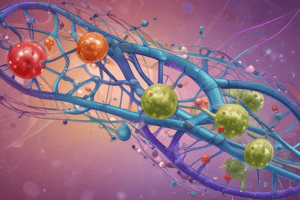Podcast
Questions and Answers
What is the primary function of gene regulation in a cell?
What is the primary function of gene regulation in a cell?
- To synthesize proteins
- To divide the cell
- To duplicate the cell's DNA
- To control which genes are turned on or off (correct)
What triggers the chemical events that activate transcription factors in a cell?
What triggers the chemical events that activate transcription factors in a cell?
- The binding of a growth factor to a receptor protein (correct)
- The synthesis of a protein
- The replication of DNA
- The binding of a transcription factor to DNA
What is the result of more open or 'relaxed' chromatin structure?
What is the result of more open or 'relaxed' chromatin structure?
- The gene is less available for transcription
- The gene is more available for transcription (correct)
- The gene is deleted
- The gene becomes mutated
What is the role of transcription factors in a cell?
What is the role of transcription factors in a cell?
Why do different cell types in the body have different sets of active genes?
Why do different cell types in the body have different sets of active genes?
What is a key point of regulation in eukaryotic gene expression?
What is a key point of regulation in eukaryotic gene expression?
What is the primary function of transcription factor proteins?
What is the primary function of transcription factor proteins?
What is the outcome of alternative splicing of pre-mRNA?
What is the outcome of alternative splicing of pre-mRNA?
Which transcription factor is connected to many fibrotic diseases?
Which transcription factor is connected to many fibrotic diseases?
What is the role of the STAT3 protein in cellular functions?
What is the role of the STAT3 protein in cellular functions?
What is the outcome of RNA processing?
What is the outcome of RNA processing?
Which of the following is a prominent cluster of diseases connected to transcription factors?
Which of the following is a prominent cluster of diseases connected to transcription factors?
Flashcards are hidden until you start studying
Study Notes
Gene Regulation
- Gene regulation is the process by which a cell controls which genes are "turned on" or "off" to produce specific proteins and perform specific functions.
- Despite having the same DNA, different cell types in the body have unique sets of active genes due to gene regulation.
- Gene regulation leads to different patterns of gene expression, resulting in distinct sets of proteins and specialization of cell types.
Gene Expression
- A cell's gene expression pattern is determined by information from both inside and outside the cell.
- External signals, such as growth factors, bind to receptor proteins on the cell surface, triggering a series of chemical events that activate transcription factors.
- Transcription factors bind to specific DNA sequences, causing transcription of genes related to cell division and growth.
Regulation of Eukaryotic Gene Expression
- Gene expression can be regulated at multiple stages, including chromatin accessibility, transcription, and RNA processing.
- Chromatin structure can be modified to make genes more or less accessible for transcription.
- Transcription factors can promote or repress transcription by binding to specific DNA sequences.
- RNA processing can be regulated through splicing, capping, and poly-A tail addition.
Transcription Factors and Disease
- Transcription factors are connected to diseases through regulatory networks.
- Specific transcription factors, such as STAT3, E2F1, and E2F4, are linked to certain diseases, including fibrotic diseases and breast and ovarian cancer.
- The STAT3 protein is involved in multiple cellular functions, including cell growth, migration, and apoptosis.
Role of STAT3 in Breast Cancer
- STAT3 signaling pathway plays a role in breast cancer development and progression.
- STAT3 is active in tissues throughout the body and can promote cell growth and division.
Studying That Suits You
Use AI to generate personalized quizzes and flashcards to suit your learning preferences.




